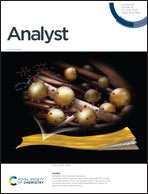Y3+@CdTe quantum dot nanoprobe as a fluorescence signal enhancement sensing platform for the visualization of norfloxacin†
Abstract
Quinolone antibiotics (norfloxacin) pose a serious threat to animal and human health due to their misuse and difficulty in being broken down in surface water and food. Rapid and effective detection of norfloxacin (NOR) is essential for environmental testing and ecosystems. In this study, yttrium was coordinated with mercaptopropionic acid (MPA)-modified CdTe quantum dots (QDs) to obtain a novel fluorescence sensor Y3+@CdTe QDs for the sensitive detection of NOR. NOR can bind to Y3+ to form a complex (NOR–Y3+). This complex enhances the luminescence of NOR and blue-shifts to 423 nm. The fluorescence intensity of NOR–Y3+ at 423 nm (I423) gradually increased with increasing NOR concentration; meanwhile, the fluorescence intensity of CdTe QDs at 634 nm (I634) gradually decreased due to aggregation induction. The ratio of I423 to I634 was used for the quantitative determination of NOR. The linear range of the constructed fluorescent probes was from 1.0 to 150.0 μM, with a detection limit of 31.8 nM. CdTe QDs act as a red fluorescent background, and with the addition of NOR, the color of the system transitions from red to purple and finally blue. This method was rapid (immediate) and visual, providing a simple analysis of various actual samples (tap water, lake water, honey, milk and human serum) for NOR.

- This article is part of the themed collection: Analyst HOT Articles 2023


 Please wait while we load your content...
Please wait while we load your content...